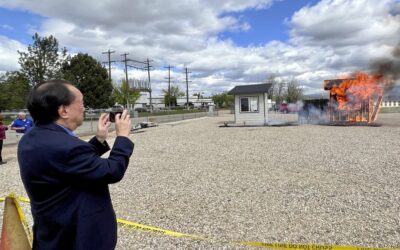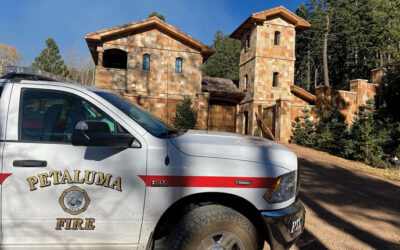A look at changes from the tragic 2006 Esperanza Fire
BRIAN ROKOS, The Press Enterprise
In the 10 years since the explosive Esperanza fire killed five U.S. Forest Service firefighters protecting an unoccupied home in the San Jacinto Mountains, wildland firefighting tactics, philosophies and organizational culture have changed, with agencies now strongly emphasizing valuing emergency workers’ lives over buildings.
Some of the new guidelines, officials say, are inevitable improvements in fire fighting whose timing is coincidental. Others can be directly attributed to efforts to prevent a repeat of the doomed stand that the Engine 57 crew of Capt. Mark Loutzenhiser, Jess McLean, Jason McKay, Daniel Najera and Pablo Cerda made at the so-called Octagon House in Twin Pines overlooking the San Gorgonio Pass.
“For many of us who were there, there is the awareness that you never want to go through this again,” said John Hawkins, chief of Cal Fire’s Riverside Unit, which assumed initial command of the Oct. 26, 2006, fire before being joined by the Forest Service. “The job of firefighting is continually evolving, whether we have fatality fires or not. Fatality fires truly do drive the law of catastrophic reform.”
Shawna Legarza, who in June became the Forest Service’s director of Fire and Aviation, said she inherited an agency that is in transition.
“The biggest shift that we’ve made from Esperanza and Engine 57 is really trying to become a learning organization,” said Legarza, who was chief of the San Bernardino National Forest from 2011 to 2013.
It’s not that the Forest Service is just now emphasizing safety. The 10 safety-related Standard Firefighting Orders were developed in 1957; shortly thereafter, 18 Watch Out Situations also were created to avoid tragedy.
But John Phipps, director of the Forest Service’s Rocky Mountain Research Station, said those 28 rules did not consider the complexities of fighting wildland fires that can increase in ferocity at a moment’s notice because of wind, topography and temperature, and as a result, firefighters for a time were too strictly held accountable for violating them.
MISTAKES CALLED CRIMINAL
In 2001, when four hand crew members were killed battling the Thirtymile fire in Washington state, victims’ families and politicians clamored for answers and accountability. That resulted in Congress passing a law requiring that the Office of Inspector General of the U.S. Department of Agriculture, the parent agency of the Forest Service, investigate every wildland fire that resulted in a federal firefighter death.
El lreese Daniels, a Thirtymile fire incident commander, was charged with four counts of manslaughter among 11 felony charges. Eventually, he pleaded guilty to two counts of making false statements to investigators about his crew’s positioning and was sentenced to 90 days in a work-release program.
The prosecutions had a secondary effect: Federal firefighters, fearing jail, began refusing to cooperate with investigators, limiting what officials could glean from mistakes to make sure they didn’t happen again, Phipps said. Firefighters also began purchasing liability insurance and refusing supervisory assignments, according to reports.
The Inspector General’s 2009 report on the Esperanza fire said some firefighters refused to cooperate with investigators, fearing criminal prosecution. To allow the joint Cal Fire/Forest Service investigation to go forward, Inspector General investigators delayed their interviews until January 2008.
Eventually, Phipps said, Forest Service officials began to realize that firefighters still were dying despite the heavy-handed approach. The Forest Service in 2014 adopted new investigation methods that focus on learning from mistakes instead of finding fault.
“Instead of holding individuals responsible, we’re trying to hold the organization responsible for learning how to change this system so it can increase the probability that everybody goes home,” Phipps said.
No fire commanders were prosecuted in the Esperanza fire.
COMMUNICATIONS CONFUSION?
The 2013 book “The Esperanza Fire: Arson, Murder and the Agony of Engine 57,” by John N. Maclean, suggests that the Forest Service’s Loutzenhiser misunderstood what Cal Fire Battalion Chief Bob Toups said was his warning to leave the Octagon House for safety reasons, or that Toups did not clearly convey the gravity of his concern before the flames roared up a funnel-shaped creek drainage and swept over the crew in seconds with temperatures of at least 1,600 degrees.
The 118-page Esperanza Fire Accident Investigation Factual Report, released in July 2007 and jointly written by Cal Fire and the Forest Service, did not attempt to sort that out. Investigators instead wrote that they found “a loss of situational awareness concerning the dangers associated with potential fire behavior and fire environment while in a complex wildland urban interface situation,” a term for where homes abut forests. They also wrote that the decision to attempt to save the Octagon House at the head of a rapidly developing fire either underestimated or accepted the safety risk.
T he captains of four other engines protecting homes nearby rejected those assertions in a September 2007 response. Others in the fire service, including Toups, have described the title of the Factual Report as a misnomer.
The Inspector General report, meanwhile, provided a detailed account by Toups. Toups said Loutzenhiser told him he planned to leave the Octagon House when the flames approached and that he told Loutzenhiser “that this was not a place they wanted to be and that they could not fight the fire there.”
Engine 57 was to leave the Octagon House and meet up with crews in a safer area several hundred yards away when the fire was close to the bottom of the drainage area, Toups told investigators.
Hawkins, who said he believes Toups’ account, added sadly that the other witnesses to what happened are dead.
Toups retired seven years ago as an assistant chief and lives in Canyon Lake. He declined in a recent interview to talk about his conversation with Loutzenhiser. But he did say: “It’s a terrible tragedy. People like myself are still scarred by it.”
T oups now consults for a company that has developed a web-based product that can track the exact location of firefighters and fire engines and allow fire commanders to see from afar when they are in danger. Hawkins and Legarza said firefighting agencies in general are behind in adopting technology.
“I think it would significantly reduce the possibility of a terrible accident like this,” Toups said.
Tim Chavez was a Cal Fire captain when the Esperanza fire broke out about 1 a.m. He watched as a combination of heat, dry brush and Santa Ana winds caused flames to suddenly explode uphill toward the Engine 57 crew. Chavez said some of the ideas for the operating principles “definitely came out of Esperanza.”
Now a battalion chief and fire behavior analyst, Chavez said Cal Fire is getting away from putting firefighters in the path of flames.
“Oftentimes, in the first place, you are not successful, and in the second place, that’s how you kill people,” Chavez said.
STRUCTURE PROTECTION SECONDARY
The Factual Report also expressed concern over a joint Cal Fire/Forest Service firefighting plan that investigators said appeared to have emphasized aggressive structure protection over firefighter safety.
Some issues raised by the report were addressed when, in 2014, Cal Fire released the 313-page Wildland Urban Interface Operating Principles to provide better training in safety, protecting structures, leadership, fire behavior and other subjects.
“Because firefighter and civilian safety is always the first consideration, any tactical action should reflect that concern,” the document says.
Hawkins said he hopes all – local, state and federal – firefighting agencies in California will adopt the standards in the 2014 document.
The Forest Service has, in the past year, had conversations with its firefighters that emphasized their safety, Legarza said.
“We want to make sure all of our employees, when they have time to think things through, they think things through more than they have in the past. Talking about life and property and what is the most important value: human life,” Legarza said.
The Forest Service has made other changes.
The Forest Service has been ranking areas by risk to firefighters and the public, with dispatchers relaying that information to fire crews. Over 2011-12, Legarza said, the Forest Service turned over primary responsibility for structure protection during wildfires in Big Bear, Lake Arrowhead and Idyllwild to Cal Fire.
“It seemed like that was putting our firefighters in a place of more risk and a conflict of what the mission of this agency is: land management and exterior (structure) protection,” Legarza said.
Cal Fire spokeswoman Janet Upton said a “vast majority” of the homes in those areas are in locations where state and local firefighters have responsibility for structure protection.
“We are trained to do that. It’s a risk we accept,” Upton said.
The Forest Service also has completed implementing seven recommendations made by a Forest Service task force in the wake of Esperanza, including integrating its firefighting plans with those adopted by Riverside County fire safety task forces and improving risk assessment.
“Reducing risk … it will never end,” Legarza said. “We manage our risk so we can come home every single day on every single fire.”





